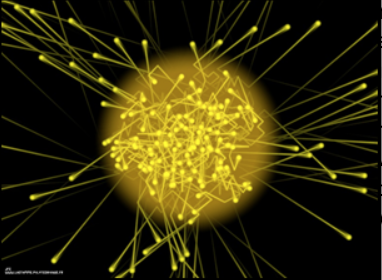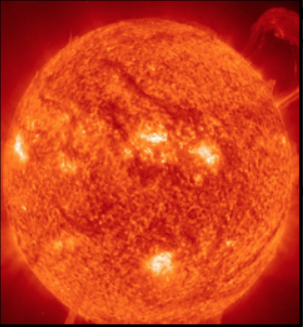Weird Matter Part 3, Elementary Particles
In the last two parts of the Weird Matter series, we explored strange substances like dark matter, dark energy, and antimatter. While they are certainly fascinating, these types of matter are either really mysterious, like dark matter and dark energy, or extremely rare and destructive, like antimatter. Today, we will instead be focusing on things we understand more and interact with on a daily basis. These are the elementary particles – and they make up everything in the universe!
Elementary Particles and the Standard Model
In the colorful table below you’ll find these elementary particles grouped into different categories. The way they are grouped is called the Standard Model. (In a later article, we’ll dive more into what this really means). Except for dark matter and dark energy, we think that everything in the universe is made from these elementary particles.
Quarks
We begin our tour with the quarks, the orange shaded region in the top left. Quarks are really tiny particles that actually makeup protons and neutrons. Protons and neutrons are what makeup atoms. So, while everything in the world is made up of atoms, remember that all these atoms are made from quarks! There are actually six types of quarks and they are grouped into pairs of two: up and down, charm and strange, and top and bottom. Pretty weird names, right?
Protons are made from two up quarks and one down quark. Neutrons are made from one up quark and two down quarks.
Gauge Bosons
If you take a look at the section colored in blue, you’ll see the gauge bosons. There are four particles that make up the gauge boson family: gluons, photons, z bosons, and w bosons.
Gluons
Let’s begin with gluons. Gluons are extremely important because they allow quarks to stick together. And if you recall, quarks are what form protons and neutrons. Their name says it all – gluons are the “glue” that hold quarks together!
Quarks are held together by gluons!
Photons
Right now, as you read, hundreds of millions of tiny little particles called photons are entering into your eyes, allowing you to see everything around you. You can think of photons as particles of light. Everything you can see is actually emitting billions of photons every second, including yourself! These photons originally come from the sun, which is why at nighttime things are darker and much harder to see. But they can also come from light bulbs, fire, and other light sources, allowing you to see even when it is nighttime.
Z and W Bosons
Z and W Bosons are the two particles that carry the weak nuclear force. The weak nuclear force is responsible for the radioactive decay of particles. Radioactive decay happens all around us, but most noticeably in places like nuclear reactors and the sun. For example, when fuel is burned in the sun to make heat and light, radioactive decay is occurring, which happens because of the weak nuclear force. You can thank the Z and W bosons for that!
Leptons
Lastly, we reach the lepton family, which includes electrons, muons, taus, and neutrinos.
Electrons
If you aren’t already familiar with these particles, electrons are tiny, negatively charged particles that circle around atoms. They are what allow for many important things like the electricity which powers your electronics and home.
Muons
Muons are like the bigger siblings of electrons… they’re 200 times heavier! Whenever really strong waves of energy from the sun called cosmic rays enter Earth’s atmosphere, they collide with atoms to create muons. Recently, muons have been used to map the inside of the Great Pyramids in Egypt!
With Muon Tomography, we can now better map the inside of the Great Pyramids.
Taus
If you thought Muons were big, wait until you hear about the Taus. Taus, pronounced “tower” but without the “r” at the end, are 3500 times heavier than electrons! Because they are so massive, Taus exist for an extremely short amount of time and are very rare in the universe. However, they can be made from particle accelerators, which are giant machines that smash particles together. Studying these taus can give scientists a better understanding of other particles, like muons and electrons.
Particle accelerators can produce tau particles by hitting other particles together really hard.
Neutrinos:
Nicknamed “ghost particles” because they are so hard to detect, neutrinos are perhaps the most elusive of all the Elementary Particles. Neutrinos form when electrons, muons, and taus decay – this is why there are electron neutrinos, muon neutrinos, and tau neutrinos. This decay happens in places where nuclear reactions occur, like in the core of our sun. One of the reasons why neutrinos are so hard to observe is that they are 10 billion, billion, billion times smaller than a grain of sand! Scientists are especially interested ins studying these particles because they could help us to understand more about the Big Bang. And here’s something to leave you with – every second, around 100 trillion neutrinos pass through your body!
This is the Super-Kamiokande, a neutrino detector under Mount Ikeno in Japan. Yes, those are people in a boat!
What about the Higgs Boson?
But let’s not forget the Higgs Boson, sitting all by itself in the corner! In fact, the Higgs Boson is probably the most important particle of the bunch – Higgs Bosons are what give all the other particles, except for gluons and photons, their mass. (Gluons and photons don’t have any mass.). You might even hear some people call the Higgs Boson the “God particle!”
Particle accelerators can also produce Higgs Bosons.
This concludes our tour of the elementary particles. While you may never be able to actually see them with your bare eyes, remember that they make up everything around you, including yourself!










